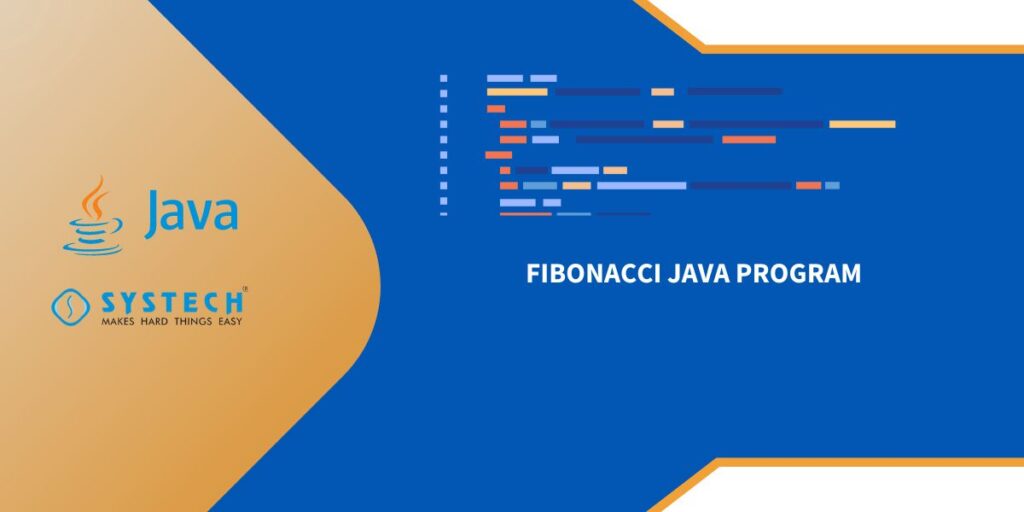Introduction :
The provided Java program generates the Fibonacci sequence up to a specified number of terms. The Fibonacci sequence is a series of numbers where each number is the sum of the two preceding ones, usually starting with 0 and 1. The user is prompted to input the number of terms they want in the sequence, and the program then prints the Fibonacci sequence up to that specified number of terms.
Algorithm :
- Import Scanner: The program begins by importing the Scanner class from the util package, allowing the user to input values.
- Main Method: In the main method, a Scanner object is created to read user input. The user is prompted to enter the number of terms they want in the Fibonacci sequence.
- User Input: The entered value is stored in the variable n.
- Fibonacci Sequence Generation: The program then enters a loop that iterates n In each iteration, it calls the fibonacci method with the current iteration index as an argument and prints the result. The fibonacci method calculates the Fibonacci number for a given index using recursion.
- Fibonacci Method: The fibonacci method is a recursive function that returns the Fibonacci number for a given index n. If n is 0 or 1, it returns n Otherwise, it recursively calls itself with n-1 and n-2, and returns the sum of the two recursive calls.
Explanation :
- The program uses recursion to calculate Fibonacci numbers, which may result in redundant calculations and inefficiency for larger values of n.
- The Fibonacci sequence is printed in the main method using a loop to iterate through the specified number of terms.
- While this program is a simple implementation, it’s worth noting that for larger values of n, the recursive approach may become inefficient due to repeated calculations. Optimized algorithms such as memoization or dynamic programming are often preferred for larger Fibonacci sequences.
Code :
import java.util.Scanner;
public class Fibonacci {
public static void main(String[] args) {
Scanner scanner = new Scanner(System.in);
System.out.print("Enter the number of terms for the Fibonacci sequence: ");
int n = scanner.nextInt();
System.out.println("Fibonacci sequence up to " + n + " terms:");
for (int i = 0; i < n; i++) {
System.out.print(fibonacci(i) + " ");
}
}
public static int fibonacci(int n) {
if (n <= 1) {
return n;
} else {
return fibonacci(n - 1) + fibonacci(n - 2);
}
}
}
Input :
Enter the number of terms for the Fibonacci sequence: 56
Output :
Fibonacci sequence up to 56 terms:
0 1 1 2 3 5 8 13 21 34 55 89 144 233 377 610 987 1597 2584 4181 6765 10946 17711 28657 46368 75025 121393 196418 317811 514229 832040 1346269 2178309 3524578 5702887 9227465 14930352 24157817 39088169 63245986 102334155 165580141 267914296 433494437 701408733 1134903170 1836311903 -1323752223
This program uses recursion to calculate Fibonacci numbers. You can run it, and it will prompt you to enter the number of terms for the Fibonacci sequence. Then, it will print the Fibonacci sequence up to the specified number of terms.
FAQs :
- Question: What is the Fibonacci series?
Answer: The Fibonacci series is a sequence of numbers where each number is the sum of the two preceding ones, usually starting with 0 and 1. It’s a classic mathematical concept used in various applications.
- Question: How can I generate the Fibonacci series in Java?
Answer: To generate the Fibonacci series in Java, you can use a simple program that iterates through the sequence, calculating each term by adding the two previous ones. This iterative approach is commonly used for efficiency.
- Question: Is there a recursive way to implement the Fibonacci series in Java?
Answer: Yes, you can implement the Fibonacci series in Java using recursion. In this approach, a method calls itself to calculate the next term in the sequence. While elegant, it’s important to be mindful of potential performance issues for large Fibonacci numbers.
- Question: What are the key components of a Java program for the Fibonacci series?
Answer: A Java program for the Fibonacci series typically includes variables to store the current and previous terms, a loop or recursion for calculation, and an output mechanism to display the series. Ensuring proper initialization and handling edge cases is also crucial.
- Question: Are there any best practices to optimize a Fibonacci series program in Java?
Answer: Optimizing a Fibonacci series program in Java involves considerations like memorization for recursive solutions, using an iterative approach for efficiency, and handling edge cases gracefully. Additionally, efficient variable handling and avoiding unnecessary calculations contribute to better performance.

